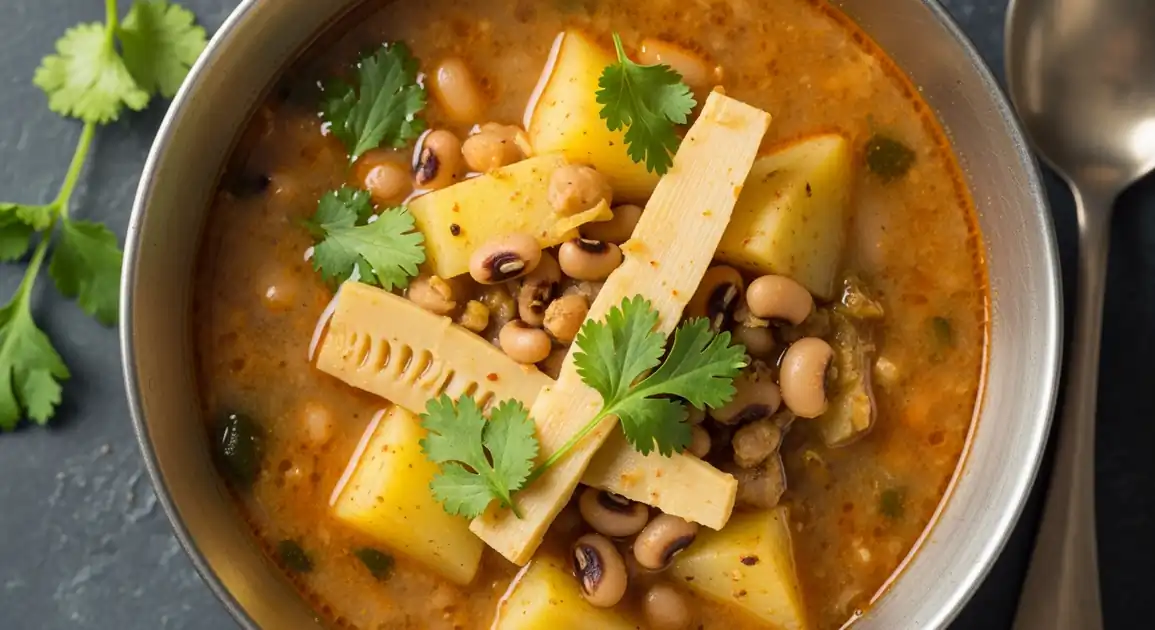Aloo Tama (Potato and Fermented Bamboo Shoot Soup)
आलु तामा

Description
Aloo Tama is a beloved staple found throughout Nepal, from the Terai plains to the Himalayan foothills, though particularly associated with the Kathmandu Valley's Newar cuisine. It's available year-round in local eateries, restaurants serving Nepali Thali/Khana sets, and is a common dish in homes.
Dietary Information
Serving information
Serving style
Served hot in a small bowl, typically alongside steamed rice ('bhaat'). It acts as a side dish or soup component within a larger Nepali meal.
Quick facts
Restaurants typically open for lunch (11 AM - 3 PM) and dinner (6 PM - 10 PM). Local eateries may have slightly different hours.
Safety Tips
What to Look For
-
Served steaming hot
Ensures the soup is cooked thoroughly and held at a safe temperature, minimizing risks.
-
Reputable restaurant or eatery
Choose places known for good hygiene and quality Nepali food for a safer experience.
-
Fresh appearance and aroma
While Tama has a pungent smell, the overall dish should smell appetizingly tangy and spicy, not spoiled or overly sour. Ingredients should look fresh.
-
Clear broth (unless intentionally thickened)
A clear, appetizing broth is typical. Excessive cloudiness (not from potato starch) might be less appealing but isn't necessarily unsafe.
What to avoid
-
Soup served lukewarm or cold
Unsafe temperature zone. Ask for it to be reheated properly or choose something else.
-
Visibly unclean serving bowls or utensils
Indicates poor hygiene standards.
-
Strong 'off' smell beyond the normal tama pungency
Could indicate spoilage of ingredients. Do not consume if it smells bad.
-
Eateries with obviously poor hygiene standards
Avoid places that look dirty or handle food improperly.
Price information
Price range
Budget tips
- Local eateries ('khaja ghar') offer the most affordable prices (100-200 NPR per bowl).
- Prices in tourist-oriented restaurants or as part of a larger set meal will be higher (200-400 NPR).
- Check if it's included in a 'Khana Set' for better value.
Value indicators
- Served hot and fresh.
- Distinct tangy flavour from well-prepared tama.
- Tender potatoes and beans (if included).
- Good balance of tanginess and spices.
Where to Find This Dish
Restaurants serving Nepali Thali/Khana Sets
Most places offering traditional Nepali set meals will include Aloo Tama or a similar vegetable curry/soup.
Throughout cities and towns
Lunch, Dinner
Newari Cuisine Restaurants
Specialty Newari restaurants often feature authentic Aloo Tama.
Kathmandu Valley (Patan, Bhaktapur, Kirtipur), Newar settlements
Lunch, Dinner
Local 'Khaja Ghar' / 'Bhatti'
Small, local eateries serving everyday Nepali food.
Neighborhoods nationwide
Lunch, Dinner
Vendor Tips
- Look for places popular with locals for authentic taste.
- If trying for the first time, maybe order as part of a set meal to sample various dishes.
- Specify if you prefer less spicy ('piro kam').
How to Order
Regional Variations
-
Aloo Tama Bodi
(आलु तामा बोडी)
The most common version, including potatoes, fermented bamboo shoots, and black-eyed peas (bodi).
-
Aloo Tama (No Bodi)
(आलु तामा)
A simpler version focusing just on potatoes and fermented bamboo shoots.
-
Spicy Aloo Tama
(पिरो आलु तामा)
Made with extra green or dried red chilies for increased heat.
-
Aloo Tama with Meat (Less Common)
(मासु हालेको आलु तामा)
Though traditionally vegetarian, some variations might include small amounts of buff (buffalo meat) or other meat, though this often becomes a different dish name.
-
Thickened Aloo Tama
(बाक्लो आलु तामा)
Some recipes might use a bit of flour or ground rice/lentils to create a thicker gravy.
Cultural context
History
Aloo Tama is deeply rooted in Nepali culinary traditions, particularly associated with the Newar community of the Kathmandu Valley but enjoyed nationwide. The use of fermented bamboo shoots (tama) stems from traditional methods of preserving bamboo, a readily available resource, making its unique flavour accessible year-round. Potatoes, though introduced later to Nepal, integrated seamlessly into this dish, creating the staple it is today.
Local significance
Aloo Tama is quintessential Nepali comfort food. Its unique tangy flavour is beloved, and the use of fermented bamboo connects it to traditional food preservation methods and reliance on local resources.
Eating customs
- Eaten with rice, usually mixed together.
- Consumed as one component of a larger meal platter.
- Spoon is used to eat the soup.